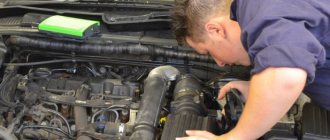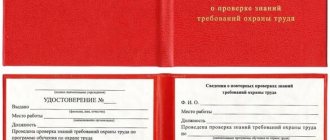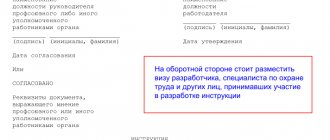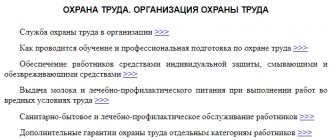Preface to the job description
0.1.
The document comes into force from the moment of approval. 0.2. Document developer: _ _ _ _ _ _ _ _ _ _ _ _ _ _ _ _ _ _ _ _ _ _ _.
https://www.youtube.com/watch?v=ytdevru
0.3. The document has been approved: _ _ _ _ _ _ _ _ _ _ _ _ _ _ _ _ _ _ _ _ _ _ _ _.
0.4. Periodic verification of this document is carried out at intervals not exceeding 3 years.
2.1. Packs semi-finished products and finished products or their individual components into containers: bags, packs, jars, tubes, vials, ampoules, bottles, carboys, boxes, bags, etc. manually without weighing, measuring and packaging.
2.2. Wraps in various wrapping materials, manually encloses items, parts and products in paper, wood, cardboard, metal and other containers with picking according to a list or specification.
2.1. It packages prefabricated and finished products or packaged components into containers: bags, packs, jars, tubes, bottles, ampoules, bowls, bottles, boxes, bags, etc. manually without any care, modification or decoration.
2.2. It is sunbathed into a cut material, placed manually into containers, parts and products into paper, wood, cardboard, metal and other containers, complete with specifications or specifications.
2.3. Wipes, blows on compressed surfaces, lubricates (preserves) and burns parts that are stored, products and waste from paper, cotton wool, cellophane and other materials.
2.4. I paste the labels.
2.5. Marks the burnt material.
2.6. Prepares paper, twine, labels, foil, etc.
2.7. Manually opens and cuts the packaging material according to the specified dimensions or template.
2.8. Places bottles, flasks, bottles in the nests of drawers and places paper, cardboard, cotton wool, shavings, thyrsa and other insulating materials between their rows.
2.9. She covers packaging containers with insulating material or places gaskets, packs - stuffs boxes, closes and seals bags, rolls the lids of metal containers manually or on a bench using technical minds.
2.10. Writes down invoices for packaged products according to the designated type, grade, berry, article, quantity, size, etc.
2.11. Take part in the folding and packaging of folding parts and components, which are expensive to assemble, together with a stacker-packer of high qualification.
2.12. Moves containers, packaging materials and packaged products in the middle of the warehouse manually or with a special lifting and transport installation, seals the outside of bottles, bottles, vials, tubes with rubber stoppers manually.
2.13. She pours tar into her necks and wipes the dances and bottles.
https://www.youtube.com/watch?v=ytcopyrightru
2.14. Stitch to seal the seal and plug the plug with clay.
2.15. I know that I understand and understand the current regulatory documents that govern my activities.
2.16. Knows and implements the benefits of regulations on the protection of food safety, adheres to the standards, methods and techniques of safe viconant work.
§ 317. Stacker-packer (2nd category)
Characteristics of work
. Packing, dosing of semi-finished products and finished products or their individual components into containers - bags, packs, jars, tubes, bottles, ampoules, pencil cases, cellophane tapes, bottles, carboys, boxes, bags, etc. manually for a given volume, weight or quantity of various solid, bulk, liquid and piece goods. Laying manually or using lifting mechanisms (cranes, electric hoists) of large-sized and heavy finished products (granite, marble, limestone, etc.). Packaging of laid parts, products and products according to technical specifications. Artistic wrapping of confectionery products by hand simultaneously in several pieces of paper (wrapper, foil, label, cellophane, etc.) with selection of the label design, compliance with the frame and other special requirements. Stowing and packaging of packaged meat and dairy products. Accounting for packaged parts, products and other products. Maintaining established documentation. Cutting and cutting packaging material on an automatic machine according to specified dimensions or template. Cleaning, lubrication, maintenance and adjustment of the machine.
Must know:
rules for packaging, dosage of semi-finished products, finished products or their individual components; the operating principle of a semi-automatic or automatic packaging machine and the interaction of its parts, technical conditions and state standards for packaged and dosed products; rules for laying, wrapping, fastening in containers and packaging large and heavy finished products; reporting rules; sizes and shape of containers for each type of packaged products, parts and goods; types, grades and sizes of fastening insulating and packaging materials.
GENERAL OCCUPATIONAL SAFETY REQUIREMENTS
1.1. Persons at least 18 years of age who have undergone theoretical and practical training, a medical examination and have no contraindications for health reasons, who have undergone introductory and initial workplace safety briefings, training in safe work methods and techniques, are allowed to work independently as a stacker-packer. on-the-job training and testing of knowledge of labor protection requirements, as well as training in electrical safety rules and testing of knowledge of electrical safety rules within the scope of job responsibilities;
training in fire safety rules and testing knowledge of fire safety rules within the scope of job responsibilities; training in safe work practices and methods of providing first aid to victims in industrial accidents.1.2. The stacker-packer is obliged to: - know and comply with the requirements of these instructions, rules and regulations of labor protection, industrial sanitation, electrical safety, internal labor regulations;
— follow the rules of behavior on the territory and premises of the enterprise; — take care of personal safety and personal health; — comply with fire and explosion safety requirements, know fire warning signals, the procedure for dealing with it, the location of fire extinguishing equipment and be able to use them;
- know the location of the first aid kit and be able to provide first aid to the victim; - know the procedure in case of emergency; - know the structure, principle of operation, rules of operation and maintenance of the filling and packaging machine, box collector, etc.; - apply in the process of work protective equipment, equipment, tools for their intended purpose in accordance with the manufacturer’s instructions;
- maintain order in the workplace; - prevent the presence of unauthorized persons in the workplace. 1.3. The stacker-packer must be proficient in safe servicing and troubleshooting techniques for a fill-packing machine, case assembler, etc..1.4. It is prohibited to approach operating machines, installations, machines on which other workers are working, and distract them with extraneous conversations, turn on or off (except in emergency cases) equipment, transport and lifting mechanisms, work on which is not assigned, go beyond the fences of dangerous areas, zones of technological passages.1.5.
The stacker-packer must undergo: - repeated instruction on labor protection in the workplace at least once every 6 months; - periodic medical examination in accordance with the current legislation of the Russian Federation; - regular testing of knowledge of labor protection requirements at least once a year. 1.6. The stacker-packer is obliged to perform only the work that is entrusted to him by the immediate supervisor of the work and the rules for the safe performance of which are known to him.
It is not allowed to entrust your work to other employees and allow unauthorized persons into the workplace.1.7. During the work process, the stacker-packer may be exposed to the following dangerous and harmful production factors: - moving machines and mechanisms (conveyors, freight elevators, floor-mounted wheeled trackless vehicles);
- moving parts of technological equipment, moving raw materials, semi-finished products, containers, finished products; - increased voltage in the electrical circuit, the closure of which can occur through the human body; - sharp edges, burrs and roughness on the surfaces of tools, equipment, inventory, containers;
- increased level of noise and vibration in the workplace; - increased temperature of equipment surfaces; - insufficient illumination of the working area; - unstable stacks of raw materials, products, containers; - physical overload; - monotony of work.1.8. The stacker-packer must be provided with personal protective equipment in accordance with the current Standards for the issuance of special clothing, special footwear and other personal protective equipment (PPE), developed on the basis of the Inter-industry rules for providing workers with special clothing, special footwear and other personal protective equipment.1.9.
We suggest you familiarize yourself with How to pick up your traffic police license after passing the exams
Issued special clothing, special shoes and other personal protective equipment must correspond to the nature and conditions of work, ensure labor safety, and have a certificate of conformity or declaration.1.10. Personal protective equipment for which there is no technical documentation, as well as with an expired shelf life, are not allowed for use.1.11.
It is prohibited to use workwear and other personal protective equipment for purposes other than the main work.1.12. It is necessary to ensure that passages, exits, and corridors are not cluttered with any objects, materials, or equipment.1.13. When working together with other employees, coordinate your mutual actions.1.14.
When operating a filling and packaging machine, box assembler, etc. the following safety requirements must be observed: - study the operating and maintenance instructions for the filling and packaging machine, box assembler, etc. before starting to work on them; - use a filling and packaging machine, box assembler, etc.
only for the purposes specified by the manufacturers.1.15. The stacker-packer must know and observe the rules of personal hygiene. Eat, smoke, and rest only in specially designated rooms and places. Drink water only from specially designed installations.1.16. It is prohibited to consume alcoholic beverages and appear at work drunk, in a state of narcotic or toxic intoxication.1.17.
The stacker-packer is obliged to immediately notify his immediate or superior manager about any situation that threatens the life and health of people, about every accident that occurs at work, or about a deterioration in his health, including the appearance of an acute occupational disease (poisoning), as well as about all noticed malfunctions of equipment and devices.1.18.
1.1. The position “Stacker-packer 1st category” belongs to the “Workers” category.
1.2. Qualification requirements - basic general secondary education or primary general education and vocational training in production, without requirements for work experience.
1.3. Knows and applies in practice: - nomenclature, grades, contents of the kit, dimensions and weight of parts and products included; - rules and methods of picking and packaging; - measures to combat corrosion; - the procedure for filling out packaging documents and accounting for packaged products and goods; - rules for lifting, moving loads and signaling during the use of lifting vehicles;
1.4. A 1st category stacker-packer is appointed to the position and dismissed from the position by order of the organization (enterprise/institution).
1.5. The 1st grade stacker-packer reports directly to _ _ _ _ _ _ _ _ _ _ .
1.6. A 1st grade stacker-packer supervises the work of _ _ _ _ _ _ _ _ _ _ .
1.7. During absence, a 1st category stacker-packer is replaced by a person appointed in accordance with the established procedure, who acquires the appropriate rights and is responsible for the proper performance of the duties assigned to him.
II. Job responsibilities
2.1. The packer performs the following functions
2.1.1. Carries out packaging, dosing of semi-finished products and finished products or their individual components into containers - bags, packs, jars, tubes, bottles, ampoules, bottles, carboys, boxes, bags, etc. manually, both without weighing, measuring and registration, and with measurements for a given volume, weight or quantity of various solid, bulk, liquid and piece goods;
— laid parts, products and products according to technical specifications, carries out artistic wrapping of confectionery products by hand simultaneously in several pieces of paper (wrapper, foil, label, cellophane, etc.) with selection of the label design, compliance with the frame and other special requirements;
This is important to know: Head of a motorcade: job responsibilities
— monumental, artistic, sculptural works, unique decorative items, complex models, working models, produces special containers and performs other similar work;
2.1.3. Performs installation:
- manually placing products, parts and products into paper, wood, cardboard, metal and other containers with assembly according to a list or specification;
— using lifting mechanisms (cranes, electric hoists) of large-sized and heavy finished products (granite, marble, limestone, etc.);
— packaged meat and dairy products;
— polished products of large dimensions with preliminary packaging by color, texture, numbers;
— fragile, expensive, poisonous, harmful, aggressive, fire and explosive cargo;
— sensitive precision instruments that require careful transportation, with particularly complex fastening in the container;
2.1.4. performs wiping, blowing with compressed air, lubrication (preservation) and wrapping of placed parts, products and products in paper, cotton wool, cellophane and other materials;
2.1.5. sticks labels, marks wrapping material, prepares paper, twine, labels, foil, etc., cuts and cuts packaging material manually or on an automatic machine according to specified sizes or templates;
2.1.6. performs cleaning, lubrication, maintenance and adjustment of the machine;
2.1.7. carries out upholstery of packaging containers with insulating material or laying of gaskets, packaging - stuffing boxes, closing, sealing, sewing up bags, rolling the lids of metal containers manually or on a machine according to technical specifications;
2.1.8. installs bottles, bottles, bottles in the nests of boxes and lays paper, cardboard, cotton wool, shavings, sawdust and other insulating materials between their rows;
2.1.9. manually caps filled bottles, bottles, vials, tubes with various stoppers, fills necks with resin, washes and wipes bottles, vials, monitors the tightness of the closure and the depth of plugging;
2.1.10. keeps records of packaged parts, products and other products, maintains established documentation, issues invoices for packaged products indicating the type, grade, quality, article, quantity, size, etc.;
2.1.11. Loads antibiotics into vending machines;
2.1.12. monitors the progress of the technological process using instrumentation and visually;
2.1.13. independently adjusts machines and their individual components during operation, checks dosages on electro-analytical balances, maintains records of performance indicators in a production log, and routine repairs of equipment;
2.1.14. Obliged to take part in the development and implementation of measures to improve the efficiency of their work, reduce costs for packaging and packaging of material assets, and introduce modern means of automation of the packaging process into the organization of the packaging workshop;
2.1.15. Must comply with labor safety regulations;
2.1.16. [fill in as required].
Pre-movement to gardening instructions
0.1. The document is typed in order from the moment of confirmation.
0.2. Document summary: _ _ _ _ _ _ _ _ _ _ _ _ _ _ _ _ _ _ _ _ _ _ _ _.
0.3. Document of services: _ _ _ _ _ _ _ _ _ _ _ _ _ _ _ _ _ _ _ _ _ _ _ _.
0.4. Periodic revision of this document takes place at intervals that do not exceed 3 days.
https://www.youtube.com/watch?v=ytaboutru
2.1. Check the serviceability of workwear, safety shoes and other personal protective equipment for the absence of external damage, put on serviceable personal protective equipment appropriate for the work being performed, fasten the shoes, not allowing free hanging ends, fasten or lace up the shoes, put on a hat.2.2. Overalls must be of the appropriate size, clean and not restrict movement.2.3.
Do not pin work clothes with pins or needles, do not keep sharp or breakable objects in your pockets.2.4. Remove wedding rings and other jewelry. Shoes must be closed. It is prohibited to wear sandals, flip-flops or other similar footwear.2.5. Receive an assignment for the current shift and, if necessary, undergo training on safe work performance.2.6.
Check by external inspection: sufficient lighting of the working surface, absence of hanging or bare ends of electrical wiring, technical condition of the filling and packaging machine, box assembler, etc. and collective protective equipment.2.7. Inspect the condition of the floors (absence of potholes, unevenness, slipperiness).2.8.
The equipment should not have sharp corners, edges or uneven surfaces.2.9. Make sure that all safety guards and the electrical cabinet door are closed.2.10. All equipment used must be reliably grounded.2.11. Remove all unnecessary items, tools, devices and documentation from the working surface of the equipment used.2.12.
The room in which the equipment used is installed must be equipped with exhaust ventilation.2.13. Check the correct operation of the filling and packaging machine and box collector at idle speed.2.14. The stacker-packer must personally verify that all measures necessary to ensure the safety of the upcoming work have been completed.2.15. If you find any malfunctions, inform your immediate supervisor and do not start work until they are eliminated.
OCCUPATIONAL SAFETY REQUIREMENTS DURING WORK
3.1. Submit to internal labor regulations and other documents regulating labor discipline issues.3.2. Comply with sanitary and hygienic requirements.3.3. Correctly use workwear, safety shoes and other personal protective equipment.3.4. Throughout the working day, keep the workplace tidy and clean, avoid cluttering the approaches to the workplace, use only designated passages.3.5.
Comply with the requirements that ensure safe working conditions and normal maintenance of the technological process when working on a filling and packaging machine, box assembler, etc. 3.6. Monitor the operation of the equipment, periodically carry out visual preventive inspection.3.7. Start up and shut down the equipment with dry hands and in strict accordance with the technological instructions.3.8.
It is strictly forbidden to: - remove the protective guards provided by the design of the equipment used; - disable the interlocks provided by the electrical circuit of the equipment used; - operate the filling and packaging machine in a humid environment; - operate the equipment in the absence of a connection between the grounding clamp and the workshop grounding circuit;
- bring your hands close to any part of the operating equipment while pushing the product; - insert foreign objects into the equipment; - work without using PPE.3.9. Access to the electrical cabinet by unauthorized persons must be prevented by locking the cabinet.3.10. Do not allow untrained or unauthorized persons to operate the equipment used.3.11.
Comply with the safety requirements set out in the description and operating instructions for the equipment, and comply with the operating modes of the equipment recommended in the manuals. 3.12. Monitor the technological process during operation. At the same time, be located in such a way as not to be exposed to hazardous production factors. 3.13.
All adjustment work, maintenance, repair, and sanitary treatment of the equipment used must be carried out only with the power supply completely turned off, with the obligatory posting of the sign “Do not turn on! People are working! Do not do this while the equipment is operating.3.14. Keep the workplace clean, promptly remove spilled (scattered) raw materials, liquids, grease, garbage, etc. from the floor. 3.15.
Do not block passages and driveways, passages between equipment, racks, stacks, passages to control panels, switches, evacuation routes and other passages with empty containers, equipment, cargo.3.16. Do not use random objects (boxes, barrels, etc.) or equipment for sitting.3.17. It is prohibited to dry work clothes, shoes, rags and other combustible materials on steam lines and heating devices.3.18.
We invite you to familiarize yourself with the Documentation on production control at hazardous production facilities
To open the container, use specially designed tools and devices. Do not perform this work with random objects or tools with burrs.3.19. Open the top of the boxes from the end side with an appropriate tool (nail puller, pliers). Remove protruding nails and bend the metal upholstery inside the box.3.20.
To open cans, use a tool designed for this purpose (can opener).3.21. When working with a knife, be careful and protect your hands from cuts. When taking breaks from work, put the knife in a pencil case (case). Do not walk or bend over with a knife in your hands, do not carry a knife that is not placed in a pencil case (case). 3.22.
When working with a knife, it is not allowed to: - use knives with loose blades, with handles that have burrs, or with dull blades; - make sudden movements; - point the knife towards you when ripping open soft containers; - cut food while hanging ;—check the sharpness of the blade by hand;
https://www.youtube.com/watch?v=ytpressru
- leave the knife in the product being cut or on the table without a case during a break in work; - lean on the musat when editing the knife. The knife should be sharpened on musat away from other workers. 3.23. Move carts and mobile racks in the direction away from you. 3.24. Transport goods only in serviceable containers.
Do not load containers with more than the nominal gross weight.3.25. Use hand protection when packing goods in rigid containers, frozen foods, etc. 3.26. Receive incoming goods onto a special table. 3.27. Turn on the supply and exhaust ventilation when packing dusty goods or in dusty containers, perform work only in personal eye protection. 3.28.
Follow the established procedure for placing goods in stacks for storage.3.29. Monitor the serviceability of the racks and prevent them from being overloaded.3.30. When working in refrigerated rooms, take precautions to prevent the possibility of accidental isolation of other workers in them. 3.31. Place the goods to be weighed on the scales carefully, without pushing, if possible in the center of the platform, without protruding beyond the dimensions of the scales.
The placement of goods on scales must be stable.3.32. Place untared (bulk) cargo evenly over the entire area of the scale platform. If necessary, clean the platform from contamination. 3.33. When constantly weighing loads weighing 50 kg or more, the scales must be installed in a special recess in the floor so that the level of the platform and the floor coincide. 3.34.
Do not be distracted from performing your direct duties and do not distract others.3.35. Do not exceed the norm for carrying heavy loads. For women, the maximum weight of the load to be lifted should not exceed 10 kg. When constantly performing (during a shift) work on lifting and moving loads, their weight should not exceed 7 kg.3.36.
When performing marking work, you should organize your workplace in such a way as to ensure the most comfortable position of the body during work and, if possible, to exclude prolonged work in a bent position, squatting or in a tensely extended position.3.37. Marking materials and marked loads must be placed at the workplace in such a way that they do not interfere with the stacker-packer during work.3.38.
Marking materials should not be stored in bulk and should not be placed close to radiators and heating pipes.3.39. Marking materials and marked loads should be placed in such a way that the possibility of them falling is excluded.3.40. Be careful when carrying loads so as not to trip over possible obstacles while walking.3.41.
While walking, do not step on electrical cables or cords of electrical consumers.3.42. When moving, you should pay attention to unevenness on the floor and slippery places (for example, after washing the floors) of the room in which marking work is being carried out, and beware of falling due to slipping;
to avoid accidents, floors must be dry and clean.3.43. Observe the rules of conduct on the territory and premises of the enterprise.3.44. Do not eat or smoke in the workplace. 3.45. If you feel unwell, stop working, notify your immediate supervisor and consult a doctor.
Packer: responsibilities and knowledge required for the profession
Let's take a closer look at the packer's profession, understand his competencies, responsibilities, skills and abilities.
A packer is a worker who packs and packages various goods and items.
Packer responsibilities:
- packaging of semi-finished products and finished products or their individual components in containers;
- wrapping goods in various wrapping materials;
- manual placement of products, parts and products into paper, wood, cardboard, metal and other containers with picking according to a list or specification;
- wiping, lubricating and wrapping stacked parts, products and products in paper, cotton wool, cellophane and other materials;
- sticking labels;
- marking of wrapping material;
- preparation of paper, twine, labels, foil, etc.;
- cutting and cutting packaging material manually according to specified dimensions or template;
- installing bottles, vials in boxes and laying insulating materials between their rows;
- upholstering packaging containers with insulating material or laying gaskets, packaging - closing, sealing, sewing up bags, rolling the lids of metal containers manually or on a machine according to specifications;
- issuing invoices for packaged products indicating the type, grade, quality, article number, quantity, size, etc.;
- participation in the stacking and packaging of complex parts and expensive products together with a stacker-packer of a higher qualification;
- moving containers, packaging material and packaged products manually or using lifting and transport equipment.
What a packer needs to know:
- nomenclature, grades, contents of the kit, dimensions and weight of stacked parts and products;
- rules and methods of picking and packaging;
- measures to combat corrosion;
- the procedure for filling out packaging documents and accounting for packaged products and goods, rules for lifting, moving goods and signaling when using lifting and transport vehicles;
- purpose and rules for using working, control and measuring tools and devices necessary for laying and packaging;
- methods of packaging goods;
- requirements for finished products and packaging quality.
The packer must be able to:
- pack the goods depending on their qualities, operating conditions and transportation;
- check the integrity of the packaging;
- use technical means when packaging goods.
The following qualities are professionally important in the activities of a packer:
- a penchant for manual labor;
- ability to perform monotonous work;
- ability to concentrate;
- spatial thinking;
- mechanical ability;
- developed hand-eye coordination;
- accuracy, consistency in actions.
Features of the profession and working conditions
The work of a packer involves manual labor using packaging equipment. The packers we select will be able to work in any industry with any product. We guarantee that our personnel have the skills and competencies that will allow them to competently and accurately perform their job duties.
According to your requirements, the packer can work either in shifts with piecework pay or part-time with hourly pay.
The material was prepared using an article on the prof resource. labor. ru
Rights
3.1. A Class 1 Packer has the authority to take action to prevent and correct any violations or nonconformities.
3.2. A 1st category stacker-packer has the right to receive all social guarantees provided for by law.
3.3. A 1st category stacker-packer has the right to demand assistance in the performance of his official duties and the exercise of his rights.
3.4. A 1st category stacker-packer has the right to demand the creation of organizational and technical conditions necessary for the performance of job duties and the provision of the necessary equipment and inventory.
3.5. A 1st category stacker-packer has the right to get acquainted with draft documents relating to his activities.
3.6. A 1st grade stacker-packer has the right to request and receive documents, materials and information necessary to perform his job duties and management orders.
3.7. A 1st category stacker-packer has the right to improve his professional qualifications.
3.8. A 1st category stacker-packer has the right to report all violations and inconsistencies identified in the course of his activities and make proposals for their elimination.
3.9. A 1st category stacker-packer has the right to familiarize himself with documents defining the rights and responsibilities of the position held, and criteria for assessing the quality of performance of job duties.
3.1. A 1st category stacker-packer has the right to use actions to prevent and eliminate any damage or inconsistency.
3.2. A 1st category packer has the right to withdraw all social guarantees provided by law.
3.3. A 1st category stacker-packer has the right to obtain agreement from the victor of his garden obligations and current rights.
We invite you to familiarize yourself with Compensation payments for work-related injuries in 2019-2020: amount and calculation of compensation, registration and receipt, documents
3.4. A 1st category stacker-packer has the right to obtain the creation of organizational and technical minds necessary for the production of gardening obligations and the provision of the necessary equipment and equipment.
3.5. A 1st category stacker-packer has the right to become familiar with draft documents that support his activities.
3.6. A 1st category stacker-packer has the right to retrieve and remove documents, materials and information necessary for the completion of their plant obligations and the order of care.
3.7. A 1st category stacker-packer has the right to advance his professional qualifications.
3.8. A 1st category stacker-packer has the right to report damage and inconsistencies that are identified in the course of his work and make proposals to eliminate them.
3.9. A 1st category stacker-packer has the right to become familiar with the documents that indicate the rights and obligations of the borrowed land, the criteria for assessing the quality of the land obligations.
III. Rights
3.1. The packer has the right:
— get acquainted with draft decisions of the enterprise management concerning issues within its competence;
— submit proposals for improvement of the activities of the packing shop for consideration by management;
— interact with other structural divisions of the enterprise, receive from them information and documents necessary to fulfill their official duties;
— submit proposals for the management’s consideration to improve work related to the responsibilities provided for in these instructions;
— demand from the management of the enterprise assistance in the performance of their official duties and rights;
OCCUPATIONAL SAFETY REQUIREMENTS IN EMERGENCIES
4.1. If an emergency occurs, you must stop the equipment, disconnect it from the power supply, report to your immediate supervisor and do not start work without his permission.4.2. If voltage is detected on metal parts of the equipment (feeling of electric current), you must disconnect the equipment from the network and report to your immediate supervisor.4.3.
The equipment must be stopped at:— the first signs of fire or the smell of smoke;— a feeling of the effects of electric current;— the appearance of unusual noise and vibration;— blockage, backup and overload with the product;— breakdowns and malfunctions;— foreign objects entering the working parts. 4.4. If smoke is detected and a fire occurs, immediately declare a fire alarm, take measures to extinguish the fire using available primary fire extinguishing equipment, and notify your or your superior.
If necessary, call the fire brigade by calling 101 or 112.4.5. In conditions of smoke and fire in the room, move along the walls, bending or crawling; To make breathing easier, cover your mouth and nose with a handkerchief (cloth) moistened with water; move through the flames, covering your head with outer clothing or a blanket, if possible, douse yourself with water, tear off or extinguish the clothes that are on fire, and if most of the clothes are engulfed in fire, roll the worker tightly in fabric (felt), but do not cover your head. 4.6.
https://www.youtube.com/watch?v=ytadvertiseru
In the event of an accident, immediately release the victim from the traumatic factor, observing your own safety, provide first aid to the victim, if necessary, call an ambulance by calling 103 or 112. If possible, preserve the situation in which the accident occurred, if this does not threaten life and health surrounding people to investigate the causes of the accident, or record it in a photo or video.
Notify your immediate or senior manager and occupational safety specialist.4.7. In the event of a deterioration in health, pain in the eyes, a sharp deterioration in visibility - the inability to focus or bring it into focus, pain in the fingers and hands, increased heartbeat, immediately leave the workplace, report the incident to your immediate supervisor and contact a medical facility.
Responsibility
4.1. The 1st category stacker-packer is responsible for failure to fulfill or untimely fulfillment of the duties assigned by this job description and (or) failure to use the granted rights.
4.2. A 1st category stacker-packer is responsible for failure to comply with internal labor regulations, labor protection, safety regulations, industrial sanitation and fire protection.
4.3. A 1st category stacker-packer is responsible for disclosing information about an organization (enterprise/institution) that is a trade secret.
4.4. A 1st category stacker-packer is responsible for non-fulfillment or improper fulfillment of the requirements of internal regulatory documents of the organization (enterprise/institution) and legal orders of management.
4.5. A 1st category stacker-packer is responsible for offenses committed in the course of his activities, within the limits established by the current administrative, criminal and civil legislation.
4.6. A 1st category stacker-packer is responsible for causing material damage to an organization (enterprise/institution) within the limits established by current administrative, criminal and civil legislation.
4.7. A 1st class stacker-packer is responsible for the unlawful use of granted official powers, as well as their use for personal purposes.
Job description of stacker-packer 2nd category
How the job description “Packer” is developed and approved. The job description of a finished product packer, like any other DI, is developed according to a general algorithm:
- The management of the organization by order appoints those responsible for the development, sets deadlines and determines the list of instructions that need to be approved;
- When ready, the project is sent for approval;
- the document is approved by a separate order or using the stamp “I approve”.
Important: the legislator does not impose any special requirements for the execution of administrative documents related to the development and approval of DI - orders can be drawn up in any form, providing space for the signatures of interested parties.
Zagalny provisions
1.1. Posad “Stacker-packer of the 1st category” is included in the category “Robotniki”.
https://www.youtube.com/watch?v=ytcreatorsru
1.2. Qualifications - basic secondary education or basic education and vocational training in the field, without work experience.
1.3. It knows the current situation in the activity: - the nomenclature, grades, together with the kit, the size and mass of parts and components that are placed; - the rules for completing and packaging; - approaches to combating corrosion; - the procedure for filling in packaging documents and the type of packaging virobіv and goods; - rules for lifting, movement of vanities and signaling during the hour of lifting and transport transport;
1.4. A stacker-packer of the 1st category is assigned to planting and is assigned to planting by order of the organization (enterprise/organization).
1.5. The stacker-packer of the 1st category is ordered without middle _ _ _ _ _ _ _ _ _ _ .
1.6. The 1st category stacker-packer is cleaned by robot _ _ _ _ _ _ _ _ _ _ .
1.7. The packer-packer of the 1st category is replaced by a special one, assigned in the established order, as soon as it is in service, which acquires the necessary rights and responsibility for the proper installation of the provisions on the new bindings.









